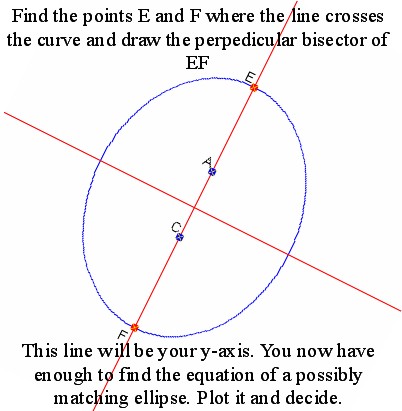Following a recent blog post relating a transformation of points on a line to points on another line to the graph of the equation relating the input and output I thought it would be interesting to explore the linear and affine mappings of a plane to itself from a geometrical construction perspective.
It was ! (To me anyway)
These linear mappings (rigid and not so rigid motions) are usually approached in descriptive and manipulative ways, but always very specifically. I wanted to go directly from the transformation as equations directly to the transformation as geometry.
Taking an example, (x,y) maps to (X,Y) with the linear equations
X = x + y + 1 and Y = -0.5x +y
it was necessary to construct a point on the x axis with the value of X, and likewise a point on the y axis with the value of Y. The transformed (x,y) is then the point (X,Y) on the plane.
The construction below shows the points and lines needed to establish the point(X,0), which is G in the picture, starting with the point D as the (x,y)

The corresponding construction was done for Y, and the resulting point (X,Y) is point J. Point D was then forced to lie on a line, the sloping blue line, and as it is moved along the line the transformed point J moves on another line

Now the (x,y) point (B in the picture below, don’t ask why!) is forced to move on the blue circle. What does the transformed point do? It moves on an ellipse, whose size and orientation are determined by the actual transformation. At this point matrix methods become very handy.(though the 2D matrix methods cannot deal with translations)

All this was constructed with my geometrical construction program (APP if you like) called GEOSTRUCT and available as a free web based application from
http://www.mathcomesalive.com/geostruct/geostructforbrowser1.html
The program produces a listing of all the actions requested, and these are listed below for this application:
Line bb moved to pass through Point A
New line cc created, through points B and C
New Point D
New line dd created, through Point D, at right angles to Line aa
New line ee created, through Point D, at right angles to Line bb
New line ff created, through Point D, parallel to Line cc
New point E created as the intersection of Line ff and Line aa
New line gg created, through Point E, at right angles to Line aa
New line hh created, through Point B, at right angles to Line bb
New point F created as the intersection of Line hh and Line gg
New line ii created, through Point F, parallel to Line cc
New point G created as the intersection of Line ii and Line aa
G is the X coordinate, from X = x + y + 1 (added by me)
New line jj created, through Point G, at right angles to Line aa
New line kk created, through Point D, at right angles to Line cc
New point H created as the intersection of Line kk and Line bb
New point I created, as midpoint of points H and B
New line ll created, through Point I, at right angles to Line bb
New point J created as the intersection of Line ll and Line jj
J is the Y coordinate, from Y = -x/2 + y (added by me)
and K is the transformed point (X,Y) Point J chosen as the tracking point (added by me)
New Line mm
Point D moved and placed on Line mm
















